|
Related FAQs: TWA
Invertebrates, Fishes of the Tropical
West Atlantic, Tropical West Atlantic
2,
Related Articles: Algae,
Vascular Plants, Introduction
to Fishwatcher's Guide Series Pieces/Sections, Lachnolaimus maxiumus/Hogfish, Hogfishes of the Genus
Bodianus,
Invertebrates, Algae and Vascular
Plants of The Tropical West Atlantic: Bahamas to Brazil, Part
2
To: Part 1, Part 3, Part 4,
Part 5, Part
6, Part 7, Part 8, Part 9,
|
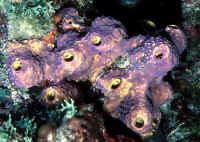 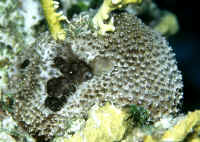
|
| Bob Fenner |
Sponges
|
Sponges, Phylum Porifera
Classification:
Sponges comprise the phylum Porifera, whose name means
"bearing openings"; an allusion to their overall porosity and
general mode of feeding (filtration), respiring, excreting wastes while
whipping water in through openings in their body walls. Sponges are the
simplest form of multicellular animals, just up from protozoans and
down from cnidarians (stinging-celled like corals and anemones) in most
taxonomic schemes. They don't, in fact, have tissues or organs.
Their cells are somewhat unspecialized and quite independent, more like
a commune or colony than a single animal.
There are about 5,000 identified marine species of
sponges. There are a few ambulatory types but almost all are attached
permanently to hard or soft substratums. Sponges are found worldwide,
mostly in shallow waters; in all colors and shapes and sizes, from a
thumbnail to a washtub. Some are cylinders, others vase-like; most are
crustose and irregular (shown: a Caribbean sponge scene off of Tobago,
Sponge scene in Tobago, Carib.).
The Porifera live up to their names by having a
characteristic arrangement of specialized cells imbedded in a spongy
matrix (spongin), incurrent pores (ostia) formed by porocytes allow water into an open space (atrium) in their
bodies and out one or more larger openings (oscula-ae). Their outer
walls are supported by non-living calcareous or siliceous structural
elements called spicules. Along with proteins
these are the sponge skeletons of bathroom sponges derived from
biological sources.
| Agelas conifera, the Brown Tube Sponge.
Typically smooth walled, brown to tan in color, smooth, velvety in
appearance. Grow in clusters, joined at base. Bonaire
pic. |
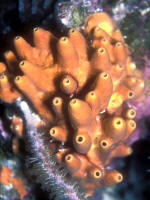
|
| Aplysina archeri, the Stove Pipe Sponge.
Long thin tubes of lavander, gray or brown. Soft to the touch.
Tropical West Atlantic. Bonaire pic. |
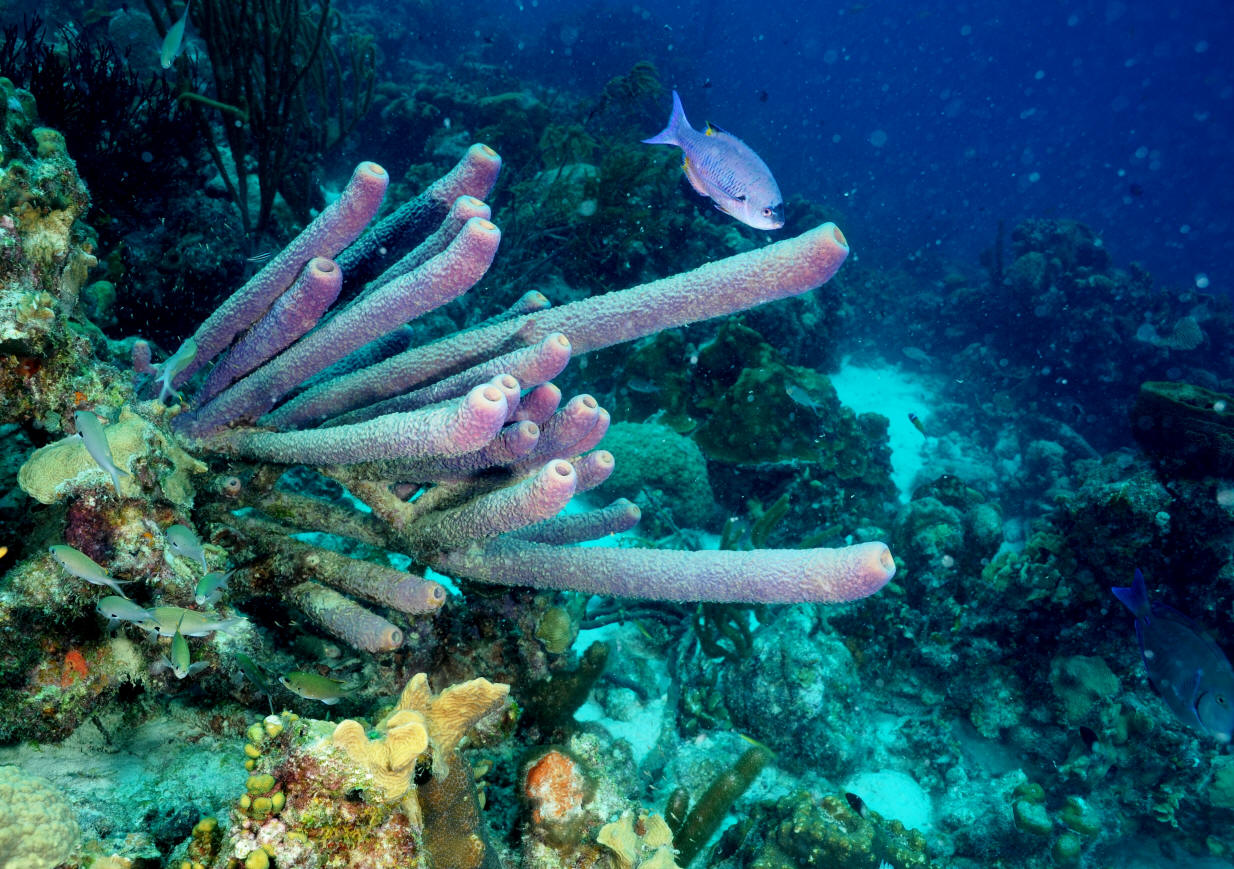
|
| Aplysina cauliformis, the Row Pore Rope
Sponge. Long rows of excurrent siphons. Occur in tints of purple,
reds. Antigua photo. |
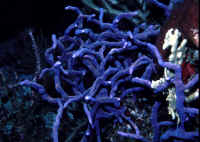
|
| Aplysina fistularia, the Yellow Tube Sponge.
Yellow to orange tubes that bear antler-like growths in shallows,
and grow longer w/o these "antlers" in increasing depths.
Don't touch! Purple color stains hands for days. Right: shallow
colony in Bahamas and deeper one in Belize . Below: young colonies
in Antigua and Bahamas, and a large one in Bonaire. |
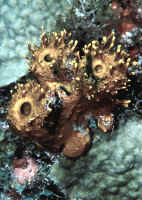 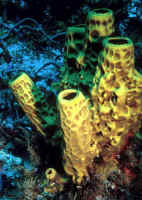
|
| Callyspongia plicifera. Azure Vase Sponge.
Bahamas pic. |
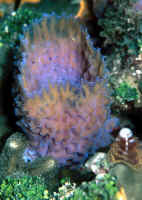
|
| Cinachyra sp. Orange Ball Sponge. Tropical
West Atlantic, to 100 foot depth, under ledges, in protected areas.
To about 1/2 foot diameter orange ball-shapes, with many excurrent
siphons riddling their surface. St. Thomas image. |
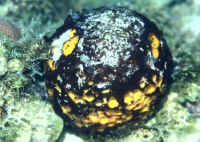
|
| Clathrina canariensis Yellow Calcareous
Sponge (Class Calcarea). A delicate, small (to four inches) bright
yellow organism, made up of intertwined tubes. Tropical West
Atlantic; usually found within caves or other shady spots. St.
Thomas, U.S.V.I. |
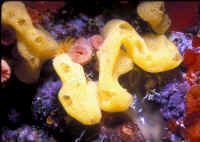 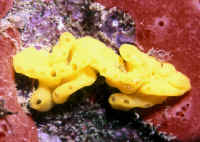
|
| Cribrochalina vasculum, the Brown Bowl
Sponge. Bahamas pix. |
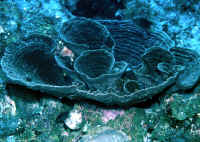 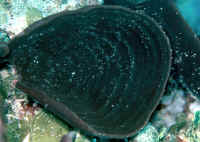
|
| Diplastrella megastellata Red-Orange
Encrusting Sponge. Caribbean. To ten inches, seventy five feet in
depth. Found in shaded areas, even under rocks, overhangs. St.
Thomas, U.S.V.I. |
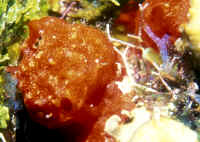
|
| Ectyoplasia ferox, Brown Encrusting Octopus
Sponge. Occurs as both encrusting and in multiple-armed arborose
morphologies. Bahamas pic. |
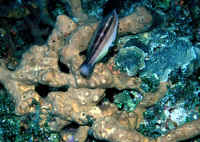
|
| Iotrochota birotulata, the Green Finger
Sponge. Made up of finger-like branches, often covered with Golden
Zoanthids (as shown). Bahamas and St. Lucia pix. |
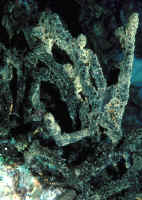 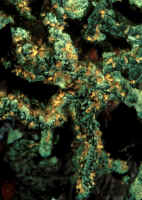
|
| Ircinia felix, Class Demospongiae. Stinker
Sponge. Light gray or brown encrusting globes, 6-12 inches in
diameter. Conspicuous hexagonal markings on surface. Smells very
bad on removal from water. Cozumel pix, close-up by Diana.F |
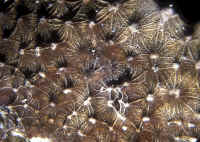 
|
| Niphates digitalis, the Pink Vase Sponge.
Pink, blue, gray. To twelve inches in height. Bahamas and Cozumel
pix. The second one acting as a host/commensal for the zoanthid Parazoanthus parasiticus. |
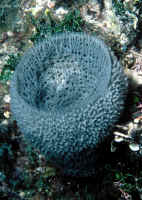 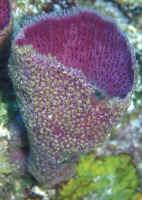
|
| Phorbas amanthus, Red Sieve Encrusting
Sponge. Cozumel pic by Diana.F. Size 6-18 in. Bright red, with
surface showing numerous craters (raised circular sieve like areas)
and small incurrent pores around protruding excurrent openings.
Reacts to touch by closing openings and pores. |
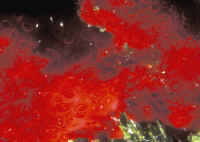
|
| Siphonodictyon coralliphagum, the Variable
Boring Sponge. Not for reef aquariums. Appears in various physical
forms, fingers to bowls, to encrusting patches. Bores into live
corals. May appear encrusting or tublular. Cancun
pix. |
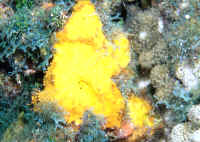 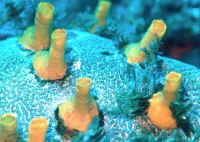
|
| Spirastrella coccinea, a relatively common
encrusting sponge, here in Cozumel, a close-up by Diana.F. |
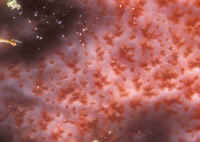
|
| Tedania ignis, Fire Sponge. Tropical West
Atlantic down to 35 ft. 4-12 inches overall. Distinctive
volcano-like excurrent openings. Orange to bright red in color
overall. Irritating to the touch. Bahamas and Bonaire
pix. |
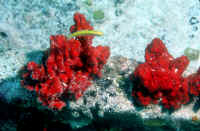 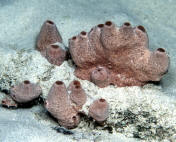
|
| Xestospongia muta, the Giant Barrel Sponge.
To six feet in height. Bahamas pic. |
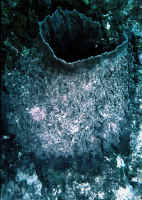
|
To: Part 1, Part
3, Part 4, Part
5, Part 6, Part
7, Part 8, Part
9, Part 10, Part
11, Part 12, Part
13, Part 14, Part
15,
|
|

